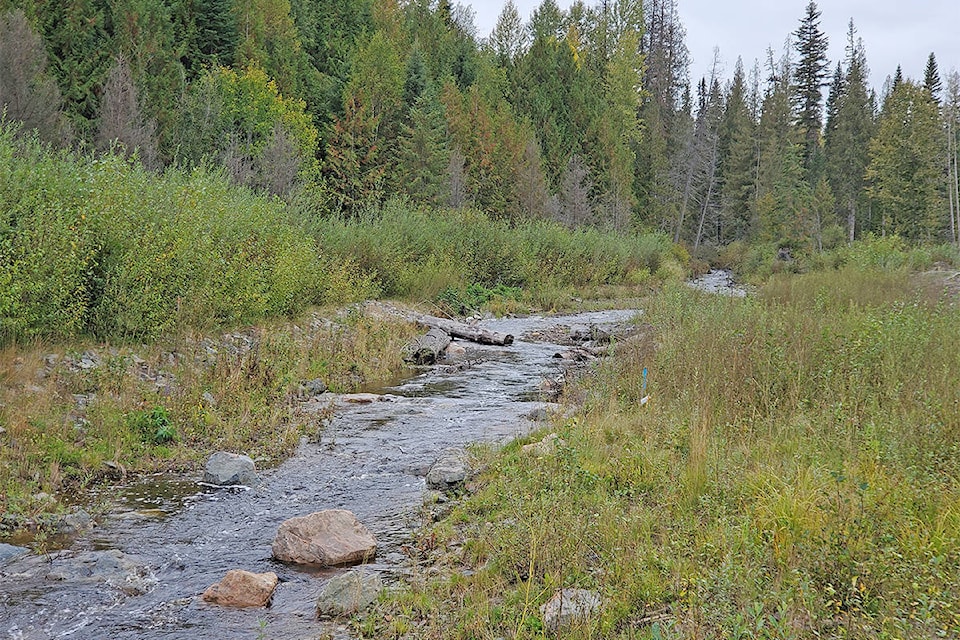The Mount Polley mine is on care and maintenance status, with a small crew of about 12 people. During this period, Mount Polley is investing in the future and undertaking exploration on and around the mine site. Both geochemical and geophysical surveys have been completed, and follow-up exploration drilling is being planned. Mount Polley is hopeful that this exploration will discover additional copper and gold resources, and thus extend the mine life, once the copper price improves and the mine is able to reopen.
Remediation work at the mine site continues. Last summer, the mine completed installation of more new fish habitat in Hazeltine Creek, with work now completed on over five km of the creek. The rainbow trout from Polley Lake continue to use the new fish habitat in upper Hazeltine Creek, including over 4,000 spawners that were estimated to have used the creek in the spring of 2019. The trout population in Polley Lake is healthy and growing.
In addition, the reconstructed fish habitat in lower Edney Creek is being successfully used by salmon, with many sockeye spawners observed using the rebuilt portion of the creek last fall. In fact, every species of fish that used Edney Creek prior to the tailings spill have been observed using the reconstructed part of the creek, indicating that the new habitat is supporting the creek ecosystem.
Read More: Five years after Mount Polley Mine breach, resident still feels ‘angry, betrayed’
Planting of new vegetation in Hazeltine Creek continued in the summer of 2019. A total of over 600,000 native trees and shrubs have now been planted, with the main species including black cottonwood, willow, Sitka alder, black twinberry, red osier dogwood, and conifers. Wildlife is often seen using the remediated habitat around Edney and Hazeltine Creeks.
While there has been no field work over the past winter, plans are in development for further remediation work on lower Hazeltine Creek this summer, with most of the work to take place in the creek valley below the Ditch Road. The final decisions on the remediation plans for lower Hazeltine Creek will be made in consultation with the Habitat Remediation Working Group, whose membership includes representatives of the T’exelc First Nation, the Xat’sull First Nation, the provincial and federal governments, the mine and its consultants.
It is very important a mine does not retain too much water on site. Mount Polley has a permit to discharge treated (cleaned) water at depth into Quesnel Lake, with strict water quality limits in place, both at the water treatment plant and in the lake. Interestingly, Mount Polley’s site water usually meets these requirements even before treatment. The mine is also continuing to do research on passive treatment of water on site, and looking into options for releasing water into watersheds closer to the mine itself, and reducing the amount of water going directly into Quesnel Lake.
Read More: Mount Polley Mine eyes drilling permits for further exploration
The mine continues to monitor its site and discharge water, and the mine and government monitor the water quality in Quesnel Lake. To date, no negative effects of the mine’s discharge on sensitive aquatic species, or of surface water quality, have been identified in the monitoring data.
Data that is collected on surface water monitoring sites can be viewed on the provincial government website , which provides an interactive map that can be searched for sample results collected from Quesnel Lake (and many other lakes and streams throughout BC). The website is https://governmentofbc.maps.arcgis.com/apps/webappviewer/index.html?id=0ecd608e27ec45cd923bdcfeefba00a7 or you can search the Internet for “BC Government Surface Water Monitoring Sites”.
Although the mine has only a small crew on site, Mount Polley continues to host site tours so people can see the remediation work that has been done. Last fall they toured a group from the Global Tailings Review (a group based in Europe), and a group of Williams Lake area teachers organized through MineralsEd.
Mount Polley plans to hold another public tour this summer, so people can visit the site to view the new fish habitat and observe the environmental recovery. The mine will publish notices in the paper and online when a date has been set for their next public tour. Stay tuned!
Don Parsons, chief operating officer, Imperial Metals.
Do you have a comment about this story? email:
editor@wltribune.com
Like us on Facebook and follow us on Twitter.
